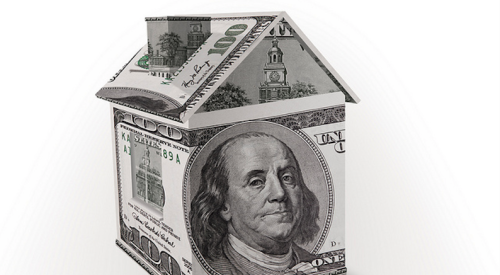Ever since the harrowing movie The Perfect Storm, where the world’s sexiest man and his fishing trawler perform a backflip off the largest rogue wave of all time, the term “perfect storm” has topped the charts for phrases that managers, pundits, consultants, and writers use to provoke a response from their audiences. But, try as I might, I can’t think of anything more apt to describe the prognosis for the home building industry in 2015—with the addition of “a twist” because the current situation involves a combination of factors I’ve not seen in my nearly three decades in the business. Those factors will make 2015 one of the most frustrating years ever for builders, and most will be stuck with declining margins, able to do little about it. It doesn’t have to be that way, but to understand how to fix it, let’s start with the twist and work back from there.
The twist is the good news—and there’s a lot of it. First, the economy. As I write this, we are coming off the best three consecutive months of job growth in 17 years. That’s a big statistic, and it’s even larger because the number—around 750,000—is about double what’s required to sustain a normally good growth pattern. (OK, it needs to be double as we claw our way out of a depressed period and have a lot of catching up to do. But the positive impact is inarguable, and more people working can only be good news for housing.)
Second, although we hear constant gnashing of teeth over the quality and pay for these new jobs, the most recent reports show that compensation is also climbing, once again in catch-up mode. So can we dispel that negative as well?
An oft-cited caveat is that many people have simply dropped out of the job market and are permanently unemployed and living on the dole. Yet even with the tremendous job growth of the past quarter, unemployment edged up slightly. While that sounds like a contradiction, economists insist that this is a good thing because it means folks are reentering the job market. More employed citizens translates to increased spending for goods, services, and housing. Meanwhile, government takes in more tax revenue and pays out less for welfare. That equals deficit reduction, provided we don’t simply spend the excess.
All About the Politics
There is a caution though. An election is just two years away. With the housing market up, the auto industry working overtime, profits growing in almost every sector of the economy, a strong dollar, and a record stock market, Republican and even Democratic presidential nominees will be working hard to convince you that things aren’t as good as they seem—because they have to. President Obama’s approval rating is so low that anything associated with him, even good news, has to be distanced.
The point is, there will be a barrage of speeches, ads, and Fox/Talk rants from presidential hopefuls about how things really aren’t much better—the evidence notwithstanding. It will be interesting to see how this negativity affects public perception.
For now, the economic improvements translate into strong housing demand. More workers mean more housing. Most researchers and pundits project in the neighborhood of 1 million starts in 2015, and one of the leading housing economists projects a 26 percent increase. That simply can’t happen because of the increasing trade shortage—one of the storm factors cited below—but regardless, herein lies the twist: Despite the strong economics and structural demand, we keep reading that Millennials find themselves priced out of the market.
That’s important because it blocks up the pyramid at the bottom. What’s worse is a February 8 report by Erik Franks, manager of information management at John Burns Real Estate Consulting, that visually depicts an all-time record gap between the sales price of new homes compared with that of resale housing. I’ve always heard that the gap should be 10 to 12 percent, not more than 15 percent. Yet this chart shows the smallest gap at nearly 20 percent—at times it’s in the 30 to 40 percent range, on up to a couple of high-end builders exceeding 100 percent. This implies that people are being priced out of move-up housing as well. Not good.
The bottom line is that the price of new homes exceeds existing homes by far too much. The message is clear: If you think you’ll get significantly higher retail prices in 2015 for your homes, you’re kidding yourself.
So demand is potentially strong, but only if we get the pricing down? Just how likely is that? Few will figure out how to do it, so most builders will fail to tap into this demand with the margins they need. You may be skeptical, so get your team together, or a group of builders together, and ask the questions that I have asked roomfuls of people at recent industry presentations. While contemplating the warm-fuzzy feeling of all this talk of increased demand, I ask how many believe that during 2015 you will experience lower costs for the following:
1. Raw land?
I have yet to see a single hand go up to this question, as most distressed land beyond scattered lots is already spoken for. My hometown of Detroit, now enjoying its own remarkable resurgence, has had busloads of Texans combing the city during the past two years looking to buy land. You know the old saying, “Follow the money?” I suggest that “Follow the Texans!” may be just as strong an indicator. Raw land is up virtually everywhere.
2. Land development?
Once again, no hands appear. OK, it will cost less to fuel the Cat this year, so maybe the graders can hold the line, but surveying, engineering, plot planning, legal fees, and all the material including pipe, gravel, and concrete are subject to demand-induced price hikes, so count on a significant increase.
3. Entitlement?
Again, no joy. Impact fees and permits will head nothing but north due to governments’ insatiable need to raise revenue without being accused of raising taxes. This is tricky business, and you have to understand the motivation. Case in point: Michigan desperately needs a billion dollars for road repairs. Rick Snyder, our Republican governor, “manned up” and called for a 10 cents-per-gallon fuel tax hike for one thing only: road repair. An engineer by training, his unassailable logic suggested that we raise the revenue from exactly those who use the service and in direct proportion to the amount used. What a concept! The legislature, however, scared to death that the Koch Brothers or “Americans for Perfect Roads for Free” would attack them for supporting such a tax hike, punted the decision to the citizens by putting a 1 percent sales tax increase proposal as a public referendum on the spring ballot. This way they can claim, “We didn’t raise taxes, the people did!” And so it goes with impact and permit fees. You can raise a lot of cash without technically increasing taxes. The beat goes on. Entitlement is up with a bullet.
4. Trade labor?
After the laughter subsides, all that’s left to discuss is how much of an increase you can expect. Does it have to be this way? For all but a few, yes. But serious mitigation is possible, and some builders will pay far more than others and think it’s just an industry-wide phenomenon. The only solution for getting not just the best trades but the best crews at a competitive price is to dedicate yourself to truly becoming the “builder of choice.” Start by asking yourself a tough but revealing question: What—besides throwing a higher bid price at them—can we do for our trade contractors to help them become more profitable? Then ask the trades directly—all of them. It will change the way you do business and will hold down costs, if you’re willing to listen, learn, and respond.
5. Material?
I attended a January meeting where a national purchasing manager from a Top 20 U.S. builder hurt badly in 2014 by trade shortages declared that the company expected to be similarly hurt in 2015 by material shortfalls. He went on to say that most builders will be caught by surprise over this issue. His company is now challenging itself on how to build supplier loyalty much the same as it has worked with its trade contractors. Has your firm anticipated this area of cost increase? I’m guessing not, so you should immediately engage, or you will be paying more.
6. Overhead?
One of the strongest turnaround indicators is the continual posting of want ads to LinkedIn groups and job boards for all types of home building personnel. “Do you know anyone?” calls and e-mails to our office have exponentially increased during the past year due to both growth and because so many experienced people have left the industry. Personnel costs are just one factor in overhead, but we know they’re going up as competition for good people increases. Office rent is also sure to increase, as we just found out in discussions to renew our lease in Michigan.
7. Financing?
It seems inevitable that with the economy improving there will be some upward rate pressure. At the very least, financing costs aren’t going down. When people compete for money, like anything else, the price climbs. Wasn’t it just a couple of years ago that we read articles about the dangers of coming deflation? Seems like ancient history now.
8. Sales, marketing, and advertising?
Everyone is trying to make up for the losses of the down years, and we can’t expect much difference here. They all want more, and who can blame them? On one hand, we now have more ways to skin this cat, but on the other, there are more arenas we feel compelled to enter. I mean, we have to have Twitter, right? And the company Facebook page? And 33 LinkedIn Groups, and Pinterest, and … and … and … So now we need a person and software to manage all of that. Oh, and don’t forget that the Parade of Homes is back in a big way, so we have to be represented there again. And convincing those Millennials to come and look and buy is harder than it used to be. Sigh. This cost’s going up, too.
9. How many believe that the retail sales price will increase enough to cover increases in 1 – 8?
Let’s get serious now. The smartest people I know in the research and marketing world say that sales price pressure is down, not up. Yes, there is demand, but if constrained by price, how will it manifest itself? Do you really think you can average 5 percent more this year? How about 3 percent? Or zero? What’s the outcome?
10. How many believe that your profit will increase in 2015?
Given your answers to 1–9, let’s just let this one sit for a minute. If, after staring down the brutal realities of Questions 1–9, you can answer a heartfelt “Yes!” to question 10, you’re either living in a fantasy or you have a definite plan of action to help you find dollars you’re not finding today either by earning a higher sales prices or reducing cost, or both—and that plan had better be specific and intentional with assignments and accountability established. Managing by memo such as strongly urging everyone to work harder and smarter and to stop wasting money doesn’t count.
The math is pretty simple. In questions 1–8 you’re looking at an average cost increase of at least 5 percent and probably more. To cover that and to maintain your margin, you need a sales price increase of 8 to 10 percent. Unless you’re in a specialty niche producing a short-term bonanza or are still living off that incredible land-buy from five years ago, this means one thing: Most builders, unless they do some things very differently in 2015, will experience decreased profit.
Doing It Differently
So what would doing things differently look like? I know this much, the solution isn’t to simply tweak current systems or just do more of the same, doubling down and working harder.
We have data from 125 builders showing more than $60,000 of waste in product and process in the average $250,000 to $300,000 home built in the U.S. That’s an average of about $10,000 in each of six cost buckets that could be tapped without dumbing down the houses or beating up suppliers and trades. I don’t know any builders yet who have accessed all of the sources, totaling about 20 percent of sales price, but some are halfway there. Imagine what a difference it would make if you could find and eliminate say just 4 percent of sales price?
Take that 4 percent and multiply it by your average sales price, let’s say $250,000. Now take that $10,000 and multiply it by your closings goal for the next 12 months, let’s say it’s 50 units. That’s a half million dollars, which can spell the difference between just getting by and making real money. For a 200-unit builder averaging a $350,000 sales price, that 4 percent looks like $2.8 million. Is that worth a bit of trouble to pursue? The waste is there, the data is undeniable. All you have to do is find it.
In next month’s article, I’ll help you do that. We’ll look in detail at the six specific buckets—the sources of excess cost and waste amounting to 20 percent of your sales price. Meanwhile, challenge your team to discover your firm’s sources. Get a group consensus on what they are, how much they could hold, and how you might pursue them. To get to the root causes, however, requires a safe environment where everyone can be completely honest with no fear of retribution. After all, it’s inevitable that some of the sources will point right back to the management team. No pain, no gain. Now and then, an old cliché says it best.













